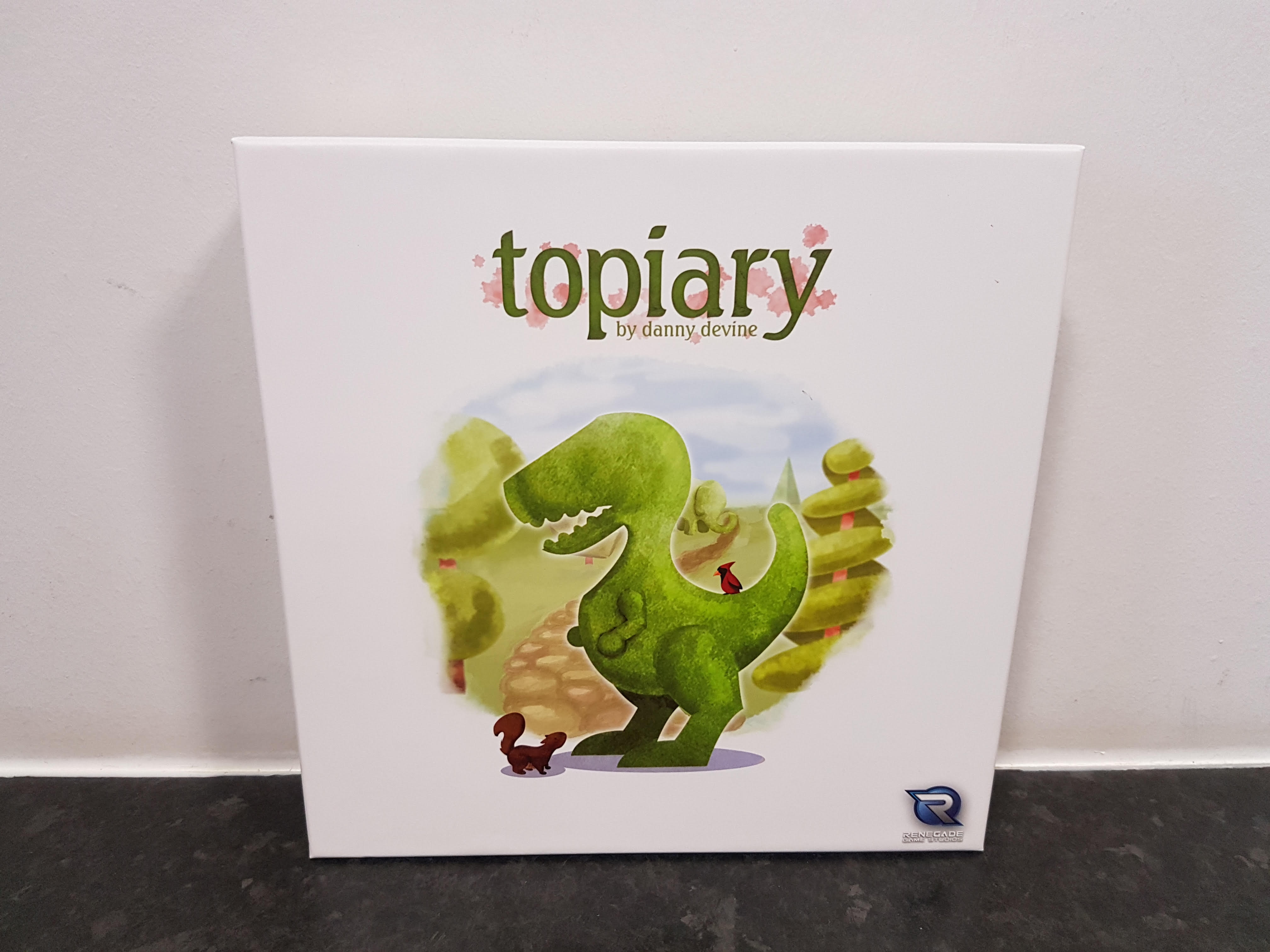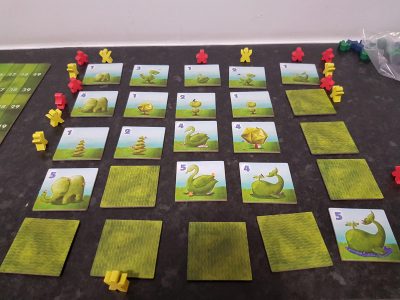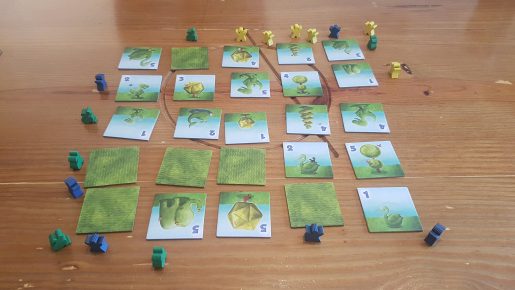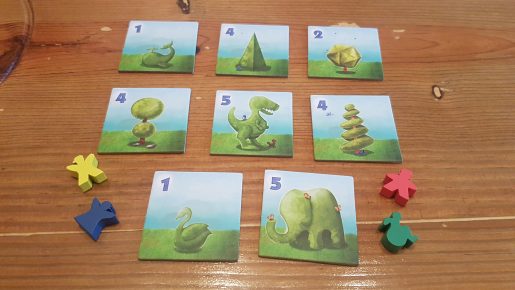Topiary is a one of the new breed of abstract puzzle games, which has a theme overlaid. The gameplay revolves around tile placement, worker placement and area control mechanisms. Released in 2017 this board game from designer Danny Devine and publisher Fever Games is still very much hot of the press. It sees 2 – 4 players spend 15 – 25 minutes getting visitors to a topiary sculpture park and into positions for the best view. However, does Topiary make the cut or should it be leafed alone? Let’s find out?
Setup is extremely fast, taking around a minute. Firstly, in a 2 – 3 player game a set of the topiary tree shapes must be removed. Each set is made up of 5 tiles, numbered 1 – 5. Then, the remaining tiles are shuffled and a 5×5 grid of face-down tiles is made. The middle tile is flipped face-up and each player gains 3 tiles, to form a starting hand. Any leftover tiles are returned to the box and players grab a number of coloured visitor meeples from the box, the number depending on the player count.
After setup is complete, the game begins with the starting player and if you follow the rules to the letter that’ll be the last person to have trimmed a real life tree. On a turn the player has a mandatory action and an optional action to perform. A player must place one of their visitor meeples at a position around the edge of the grid, facing in a direction either up or down a column, left or right on a row or diagonally. Once this has been done a player may pick up one of the facedown tiles. If they choose to do this they take the tile into their hand then choose one to replace it with face-up.
Play continues until all meeples have been placed and most probably a lot of carefully trimmed trees are face-up. This is where scoring begins and the scoreboard is removed from the box. It isn’t exactly a necessary inclusion but does speed this counting process up. Players will score for what their placed visitor meeples can see. In the direction they are looking a meeple can see any tile that is of larger number than the one before, with facedown tiles being ignored. The numbers of all tiles they can see are summed and becomes the basic points earnt by that meeple. If a meeple can see two or more of a particular set of trimmed trees, dinosaurs for example, for each one of a set an addition bonus point is awarded.
Once all meeples have been scored there is one final way to rack up some points. From the three tiles left in your hand, as long as there are higher valued tiles of that set face-up and in play, the values of the tiles are scored. This is an easily forgettable scoring mechanism, that is somewhat disjointed from the visitor/park theming. Combining all this together on the scoreboard, whomever comes out with the most points is the winner and is crowned the best topiary tour guide.
At 2 players there is an advantage to going second. Not only will you be constantly able to react, but you also have the final turn, where your plans can go uninterrupted. While this final turn issue doesn’t disappear, as the player count grows, the amount of pre-planning ahead does. This results in the reaction style gameplay being available to all, capitalising on openings left by others or blocking off the scoring they were going for. The game is still enjoyable, just expect the starting player to have a much lower win : loss ratio.
The rulebook is clear and simple to read, with a range of examples with images to make it easier to follow. They won’t take you too long to read through with the game being very much on the light side. This enables the game to be easy to teach, pick up and gets gamers into the game that bit quicker. When it comes to teaching scoring is where most questions arise but using the pieces to do a dummy end game scoring seems to clear up any and all issues.
The artwork is limited, with each tile featuring an interestingly trimmed tree, with sets of these shapes. It would have been nice to see some little, subtle, details just to differentiate tiles other than by their numbers and slightly size differences. This would have just added to the visual flair of the game but what is included is perfectly acceptable, its more being nit-picky. The quality of the tiles is high, which is more important than any illustration flairs. They should last the test of time along with the standard wooden meeples, which come in inclusive shapes.
As with any short puzzle game the length of the scoring can impact players enjoyment. If you spend half the time playing then the other counting and scoring, the balance is truly off. Topiary doesn’t have quite this issue but scoring certainly can take some time during the first few playthroughs. For example, in a 2-player game that takes around 20 minutes in total the last couple of minutes will be adding up points. This means that 10% of your time is spent not actually playing. Most will not find this an issue but when playing with younger players they can seem to lose interest during this time, making it harder to play another game than if it was possible to simply declare a winner and jump back into the action.
The take that aspect from tile placement won’t be for some, though similar to a Ticket to Ride game when with low player counts you can pick “friendly” placements. The tile placement mechanics result in a “board” that can drastically change between turns, especially in a 4 player game. As the player count drops players influence over the tiles increases and this generates a higher sense of achievement. As you start to be able impact more of the tiles you feel like points earnt, especially bonus points, are directly due to actions you’ve taken and not due to luck. As a result, 2 – 3 players is where Topiary starts to shine.
Topiary is a perfectly good game aesthetically and to play. It fits into that category due to the fun puzzle style gameplay but it does little other than the theme to captivate players. For all of the cute illustrations of whale, twirl and elephant shaped trees, the game boils down to the numbers on those tiles. For a light, fast filler then Topiary could be exactly what you’re looking for, the same can be said if its purpose to you is to be a family game. Just don’t go into the game expecting to be immersed or wanting to play game after game.
[Editor’s Note: Topiary was provided to us by Asmodee UK for review purposes. The game is currently available on 365 Games for £22.99. It is also available from local UK board game stores, find your local store here]




